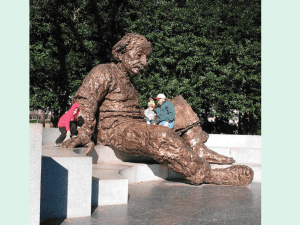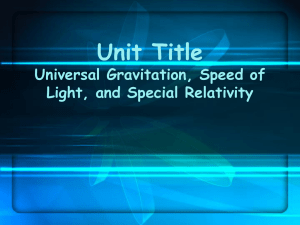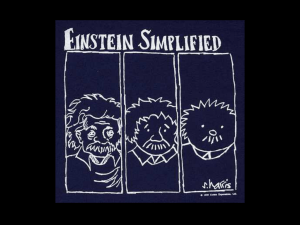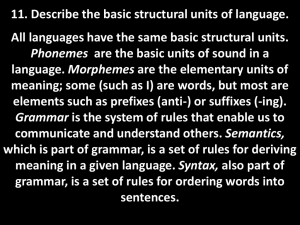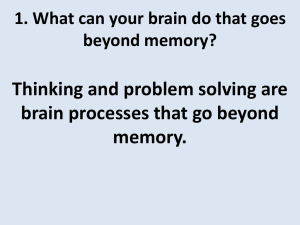Gravitational Waves in General Relativity
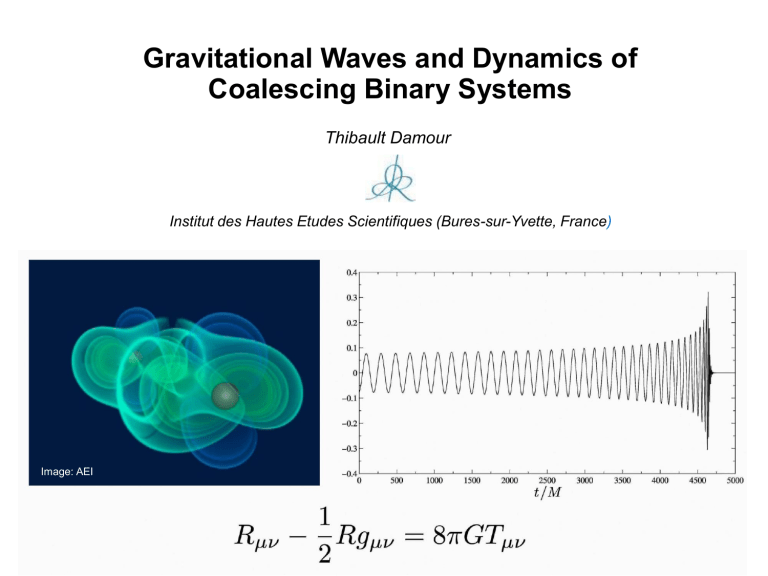
Image: AEI
Gravitational Waves and Dynamics of
Coalescing Binary Systems
Thibault Damour
Institut des Hautes Etudes Scientifiques (Bures-sur-Yvette, France )
Gravitational Waves in General Relativity (Einstein 1916,1918) g ij
= d ij
+ h ij h ij
: transverse, traceless and propagates at v=c
1
Gravitational Waves: pioneering their detection
Joseph Weber (1919-2000)
General Relativity and Gravitational Waves
( Interscience Publishers, NY, 1961 ) d
L
»
h ij n i n j
L
2
2
Gravitational Waves: two helicity states s= ± 2
Massless, two helicity states s= ± 2, i.e. two Transverse-Traceless (TT) tensor polarizations propagating at v=c h ij
= h
+
( x i x j
y i y j
)
+ h
´
( x i y j
+ y i x j
)
3
Binary Pulsar Tests I
TD, Experimental Tests of Gravitational Theories, Rev. Part. Phys. 2013 update.
4
Binary Pulsar Tests II
Binary pulsar data have confirmed with 10 -3 accuracy:
The reality of gravitational radiation
Several strong-field aspects of General Relativity
C
NS
=
æ
è c
GM
2
R
NS
ö
ø
0.2
C
BH
=
0.5
5
6
7
8
Gravitational wave sources :
9
Matched filtering technique
To extract GW signal from detector’s output (lost in broad-band noise S n
(f)) output | h template
=
ò
df o ( f ) h
S n
( f )
* template
( f )
Template of expected
GW signal
Detector’s output
Need to know accurate representations of GW templates
10
Solve
The Problem of Motion in General Relativity e.g.
and extract physical results, e.g.
• Lunar laser ranging
• timing of binary pulsars
• gravitational waves emitted by binary black holes
11
The Problem of Motion in General Relativity (2)
Approximation
Methods
• post-Minkowskian (Einstein 1916)
• post-Newtonian (Droste 1916)
• Matching of asymptotic expansions body zone / near zone / wave zone
• Numerical Relativity
One-chart versus Multi-chart approaches
Coupling between Einstein field equations and equations of motion
(Bianchi )
Strongly self-gravitating bodies : neutron stars or black holes :
Skeletonization : T
μν pointmasses ? δ-functions in GR
Multipolar Expansion
Need to go to very high orders of approximation
Use a “ cocktail ” : PM, PN, MPM, MAE, EFT, an. reg., dim. reg., …
12
Templates for GWs from BBH coalescence
(Brady, Craighton, Thorne 1998) (Buonanno & Damour 2000)
Ringdown
( Perturbation theory )
Inspiral ( PN methods )
Merger: highly nonlinear dynamics. ( Numerical Relativity )
Numerical Relativity, the 2005 breakthrough:
Pretorius, Campanelli et al., Baker et al. …
14
Binary black hole coalescence: Numerical Relativity
Image: AEI
15
16
Importance of an analytical formalism
Theoretical: physical understanding of the coalescence process, especially in complicated situations (arbitrary spins)
Practical: need many thousands of accurate GW templates for detection & data analysis; need some “ analytical ” representation of waveform templates as f(m
1
,m
2
,S
1
,S
2
)
Solution: synergy between analytical & numerical relativity
Hybrid
Perturbation
Theory
PN
Resummed
Perturbation thy
EOB non perturbative information
Numerical
Relativity
17
An improved analytical approach
EFFECTIVE ONE BODY (EOB) approach to the two-body problem
Buonanno,Damour 99
Buonanno,Damour 00
Damour, Jaranowski,Sch
äfer 00
Damour 01, Buonanno, Chen, Damour 05,…
Damour, Nagar 07, Damour, Iyer, Nagar 08
Buonanno, Cook, Pretorius 07, Buonanno, Pan …
Damour, Nagar 10
(2 PN Hamiltonian)
(Rad.Reac. full waveform)
(3 PN Hamiltonian)
(spin)
(factorized waveform)
(comparison to NR)
(tidal effects)
18
Binary black hole coalescence: Analytical Relativity
Inspiral + « plunge »
Two orbiting point-masses:
Resummed dynamics
Ringdown
Ringing BH
19
Motion of two point masses
Dimensional continuation :
Dynamics : up to 3 loops , i.e. 3 PN
Jaranowski, Sch
äfer 98
Blanchet, Faye 01
Damour, Jaranowski Schäfer 01
Itoh, Futamase 03
Blanchet, Damour, Esposito-
Farèse 04
Foffa, Sturani 11
4PN & 5PN log terms (Damour 10, Blanchet et al 11)
4PN (Jaranowski&Schaefer 13,
Foffa&Sturani 13, Bini&Damour 13)
Radiation : up to 3 PN
Blanchet, Iyer, Joguet, 02,
Blanchet, Damour, Esposito-
Farèse, Iyer 04
Blanchet, Faye, Iyer, Sinha 08
20
2-body Taylor-expanded 3PN Hamiltonian [ JS98, DJS00,01 ]
1PN
2PN
3PN
21
Taylor-expanded 3PN waveform
Blanchet,Iyer, Joguet 02, Blanchet, Damour, Esposito-Farese, Iyer 04, Kidder 07, Blanchet et al. 08
PN dynamics
DD81, D82, DJS01,IF03, BDIF04
Structure of EOB formalism
PN rad losses
WW76,BDIWW95, BDEFI05
PN waveform
BD89, B95,05,ABIQ04, BCGSHHB07,
DN07, K07,BFIS08
Resummed
BD99
Resummed
DIS98
EOB Hamiltonian H
EOB
EOB Rad reac Force
F
EOB Dynamics
.
Resummed
DN07,DIN08 h m
= h ( N , e
) m h ( e
) m h ( e
) m
=
S ( e
) eff
T m e i d m r m
BH perturbation
RW57, Z70,T72
QNM spectrum
σ
N
=
N
+ i
N
Matching around t m
EOB Waveform
23
Real dynamics versus Effective dynamics
Real dynamics Effective dynamics
G
G 2
1 loop
G 3
2 loops
Effective metric
G 4
3 loops
24
Two-body/EOB “ correspondence ” : think quantum-mechanically (Wheeler)
Real 2-body system (m
1
, m
2
)
(in the c.o.m. frame) an effective particle of mass
in some effective metric g eff (M)
H
Sommerfeld “ Old
Quantum Mechanics ” : classical (q,p)
H classical (I a
)
25
The EOB energy map
Real 2-body system (m
1
(in the c.o.m. frame)
, m
2
)
1:1 map an effective particle of
Mass
μ = m
1 m
2
/(m some effective metric g eff (M)
1
+m
2
) in
Simple energy map
26
Explicit form of the EOB effective Hamiltonian
The effective metric g eff (M) at 3PN where the coefficients are a
-dependent “ deformation ” of the Schwarzschild ones: u = GM/(c 2 r)
Simple effective Hamiltonian crucial EOB “ radial potential ” A(r)
27
2-body Taylor-expanded 3PN Hamiltonian [ JS98, DJS00,01 ]
2PN
1PN
3PN
28
Hamilton's equation + radiation reaction
The system must lose mechanical angular momentum
Use PN-expanded result for GW angular momentum flux as a starting point.
Needs resummation to have a better behavior during late-inspiral and plunge.
PN calculations are done in the circular approximation
Parameter-dependent
EOB 1.*
[DIS 1998, DN07]
RESUM!
Parameter -free:
EOB 2.0
[DIN 2008, DN09]
29
EOB 2.0: new resummation procedures (DN07, DIN 2008)
Resummation of the waveform multipole by multipole
Factorized waveform for any (l,m) at the highest available PN order (start from PN results of Blanchet et al.)
Next-to-Quasi-Circular correction
Newtonian x PN-correction remnant phase correction remnant modulus correction:
l-th power of the (expanded) l-th root of f lm
improves the behavior of PN corrections
The “ Tail factor ”
Effective source:
EOB (effective) energy (even-parity)
Angular momentum (odd-parity) resums an infinite number of leading logarithms in tail effects
30
Radiation reaction: parameter-free resummation
Different possible representations of the residual amplitude correction [Padé]
31
Extending EOB beyond current analytical knowledge
Introducing (a5, a6) parametrizing 4-loop and 5-loop effects
Introducing next-to-quasi-circular corrections to the quadrupolar GW amplitude
Use Caltech-Cornell [inspiral-plunge] NR data to constrain (a
5
,a
6
)
A wide region of correlated values (a
5
,a
6
) exists where the phase difference can be reduced at the level of the numerical error (<0.02 radians) during the inspiral
33
34
(Buonanno, Pan et al. 2011)
35
36
Main EOB radial potential A(u, ν)
Equalmass case : ν = ¼ ; u = GM/c 2 R
ν-deformation of Schwarzschild A
S
(u) = 1 – 2M/R = 1 – 2u
37
38
39
EOB-NR : SPINNING BINARIES
Theory : Damour 01 Damour Jaranowski Schaefer 07; Barausse Buonanno 10; Nagar 11…
Waveform resummation with spin : Pan et al. (2010)
AR/NR comparison : Pan et al. 09, Taracchini et al. 12, Pan et al. 13
38
EOB-NR : PRECESSING SPINNING BINARIES
Pan et al. 13
41
42
Binary neutron stars: Tidal effects in EOB
• tidal extension of EOB formalism : non minimal worldline couplings
Damour, EspositoFarèse 96, Goldberger, Rothstein 06, Damour, Nagar 09 modification of EOB effective metric + … : plus tidal modifications of GW waveform & radiation reaction
[ m
2 k
2
Damour&EspositoFarèse10 ] a
1
,...
Tidal polarizability parameters are measurable in late signals of Advanced-Ligo
[Damour, Nagar and Villain 12, Del Pozzo et al. 13 ]
44
Conclusions
Experimentally , gravitational wave astronomy is about to start.
The groundbased network of detectors (LIGO/Virgo/GEO/…) is being updated (ten-fold gain in sensitivity in 2015), and extended
(KAGRA, LIGO-India).
Numerical relativity : Recent breakthroughs (based on a “cocktail” of ingredients : new formulations, constraint damping, punctures, …) allow one to have an accurate knowledge of nonperturbative aspects of the two-body problem (both BBH, BNS and BHNS)
The Effective One-Body (EOB) method offers a way to upgrade the results of traditional analytical approximation methods (PN and BH perturbation theory) by using new resummation techniques and new ways of combining approximation methods. EOB allows one to analytically describe the FULL coalescence of BBH.
There exists a complementarity between Numerical Relativity and
Analytical Relativity , especially when using the particular resummation of perturbative results defined by the Effective One Body formalism.
The NR- tuned EOB formalism is likely to be essential for computing
45 the many thousands of accurate GW templates needed for LIGO/Virgo/...



